Asetukset
You can customize many of MuseScore's default behaviors via the menu: Edit→Preferences... (Mac: MuseScore→Preferences...).
The Preferences dialog has multiple tabs:

Reset All Preferences to Default will reset all preferences to the ones MuseScore had when you installed it.
Cancel will close the dialog without applying changes.
General
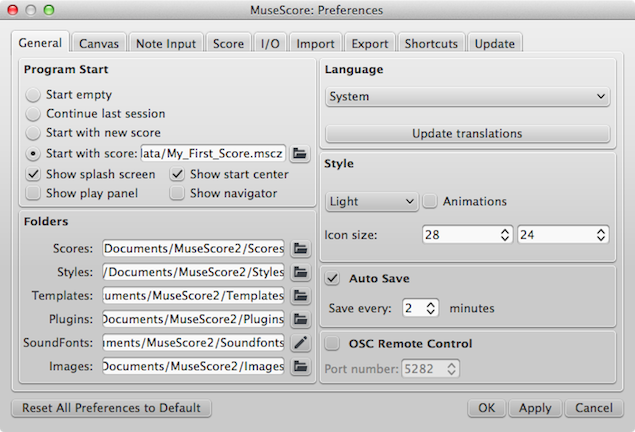
Here you can define:
- Your opening score
- The default folder to search for/save to scores, styles, templates, plugins, SoundFonts, and images
- Your auto save timing
- The languages of MuseScore (translations may be updated from here too)
- The style of your MuseScore windows and size of icons
- The windows to show at startup (Play Panel, Navigator, Start Center)
Note that language translation updates can also be done via the menu: Help→Resource Manager.
Canvas

Use Canvas to set your preferred color and wallpaper for the score background and paper.
Under Scroll Pages, you can choose whether to display pages of a multi-page score laid out in a horizontal row, or scrolling in a vertical column.
Under Miscellaneous, checking Draw antialiased (on by default) makes diagonal lines and edges of shapes look smoother (less jagged). Proximity for selecting elements controls the distance the mouse may be from an object and still act on it. Smaller numbers require more precision, making it harder to click on small objects. Larger numbers are less precise, making it harder not to click on nearby objects unintentionally. Choose a comfortable working value.
Note input
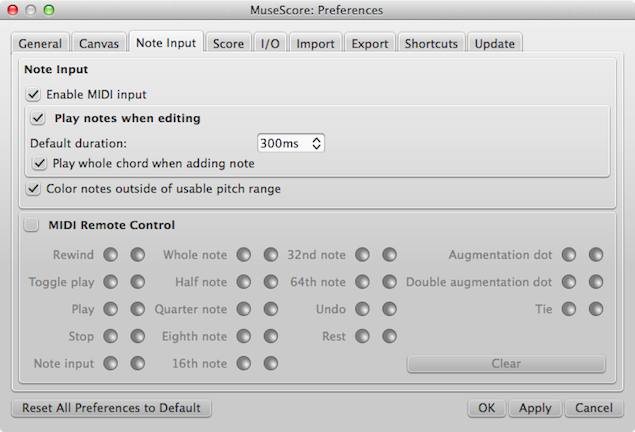
On this tab there are note input and MIDI remote control preferences. Here the following can be set:
- Enter notes via MIDI
- Enable playback on entering a note
- Its playback duration
- Color notes outside the usable pitch range
- MIDI Remote Control settings
Midi Remote Control allows you to enter or leave note input mode and also choose the duration for notes and rest directly from the MIDI keyboard as you enter notes into the score via MIDI, without having to use the computer mouse or keyboard at the same time.
The default setting for Midi Remote Control is 'off' with the checkbox blank, and all the option buttons below are grey. In order to set preferences it must be turned on with the MIDI keyboard connected.
To turn on Midi Remote Control click the checkbox, the current status of all Midi Remote Control Key settings is now indicated by the colored input option buttons:
- Green button is lit only if the MIDI key action is defined by the user.
- Red button is lit only during the preference setting process.
- By default no MIDI key actions are set and all buttons are unlit.
To enable a MIDI key operation: click the red button which lights up and stays lit until you press your chosen MIDI key for that operation and the green button is lit permanently. Once you have defined your key settings you can use the MIDI keyboard to control note input operations. You can verify your key settings by observing the MuseScore Note Input panel while pressing the MIDI keys.
To temporarily deactivate Midi Remote Control: click the Midi Remote Control checkbox, it is un-ticked and all MIDI input key action buttons are greyed. Your selections are always saved between MuseScore sessions so you can deactivate remote control at any time without losing your settings.
IMPORTANT, at the time of writing:-
1. The Clear option turns off all the green buttons for the current MuseScore session but all the user recorded MIDI key settings are retained and will be reloaded on the next session.
2. A MIDI key setting that is activated cannot afterwards be turned off and the green button will always remain lit but it can be overwritten with a different MIDI key by using the red button again.
3. Unfortunately, if the same MIDI key is used accidentally for two (or more) note inputs then both (or all) the associated green buttons stay lit but only one will work. You can fix this as in 2 above.
Score
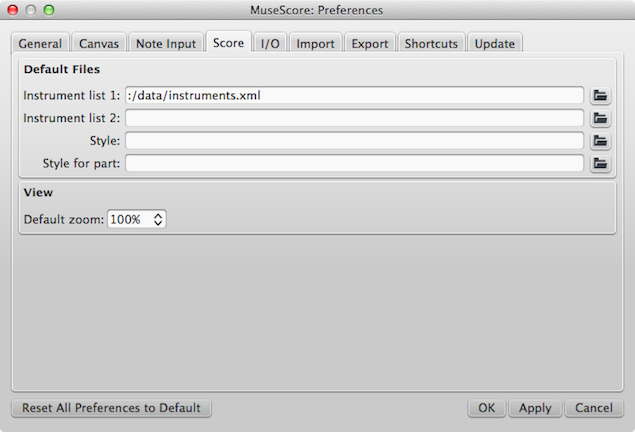
Score preferences include
- Default instrument list files (two may be selected)
- Default style for score and parts
- Default zoom
I/O
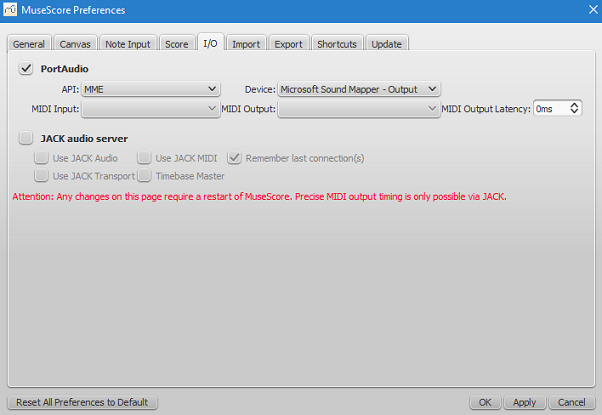
Input/Output preferences enable you to set what device will be used for audio playback (e.g., built-in speakers, USB headset, wireless, etc.), whether to use a MIDI trigger (plugged-in keyboard), and whether to route audio output through JACK.
Import
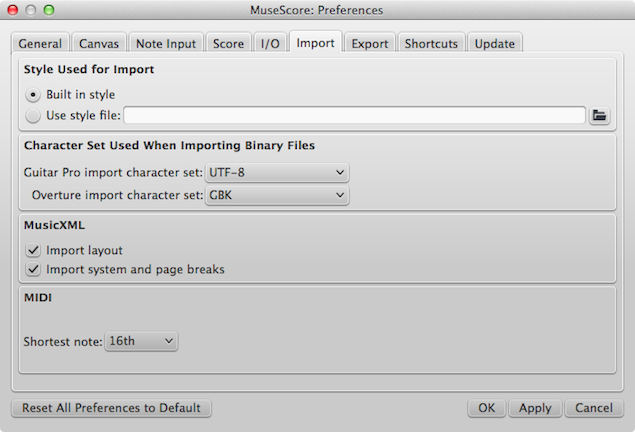
These settings determine how files from other sources are imported:
- Using either the built in MuseScore style or a style you choose
- Guitar Pro and Overture character sets
- MusicXML layout options
- Shortest note in MIDI files
Export
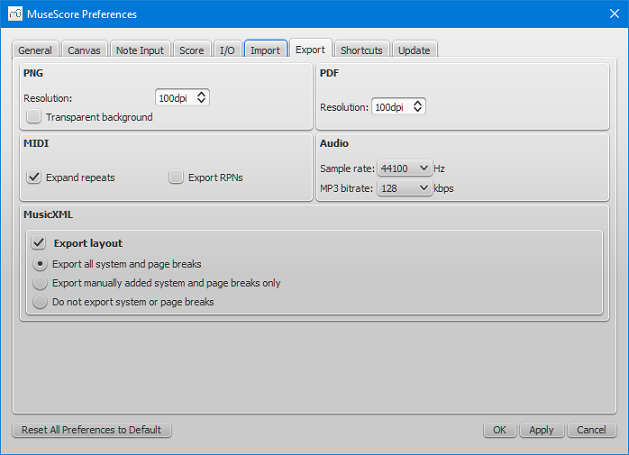
These settings determine how MuseScore files are exported:
- PNG/SVG image resolution (in DPI) and whether to use transparent background
- Whether to expand repeats in exported MIDI files
- Digital audio sample rate
- MP3 bitrate (as of MuseScore 2.1)
- Whether to export the layout and how to export system and page breaks to MusicXML
Shortcuts
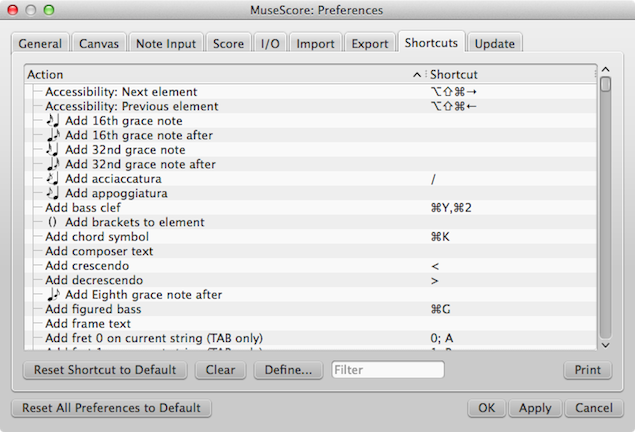
Every action possible with MuseScore is listed, with the associated shortcut if it exists. To define a new shortcut, select an existing entry in the list and click Define... (or just double click the entry), then enter the new shortcut using up to four keys. You can also reset any shortcut in the list to its default value, or clear a shortcut you select. Shortcuts listed in preferences appear next to their associated commands in the menus.
Note: Some shortcuts, including default ones, may not work with some keyboards.
The list of shortcuts can be printed out or exported to other media (pdf etc.) using the Print button in the bottom right of the window.
Update
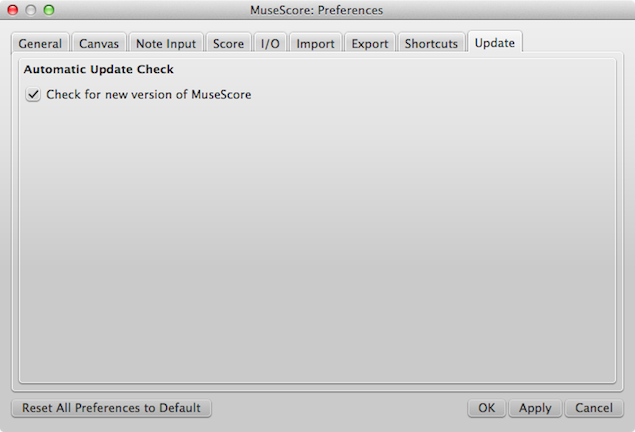
This sets whether MuseScore will check for updates at startup.
Updates may be checked manually in Help→Check for updates